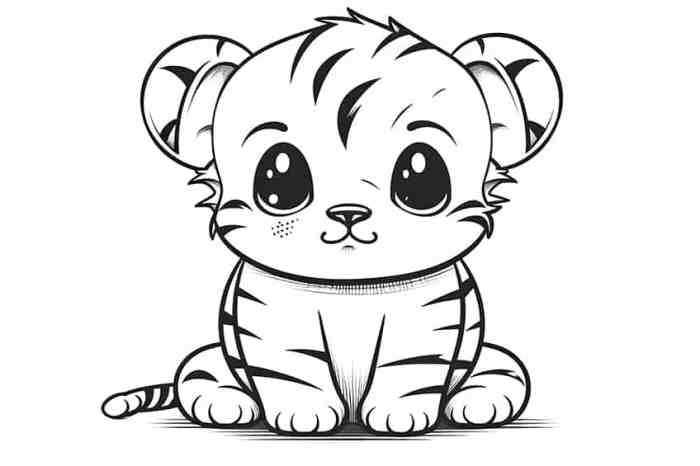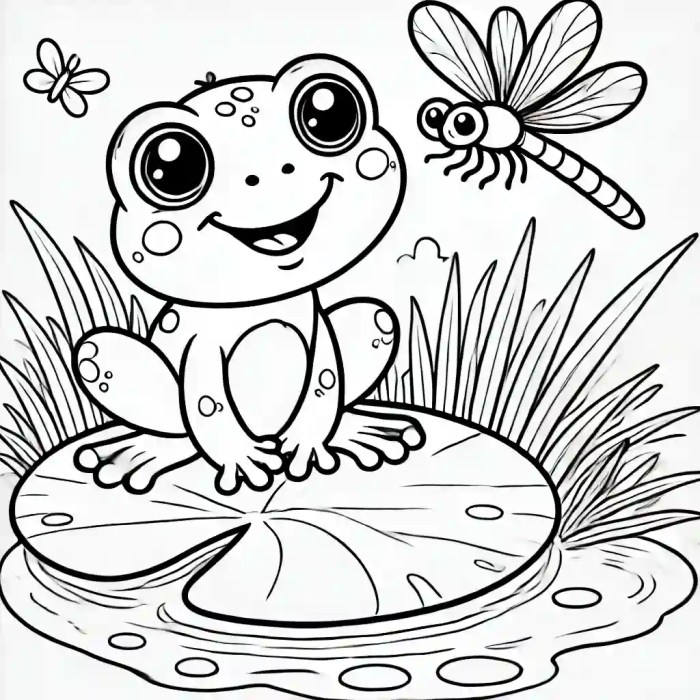Target Audience & Design Considerations
Easy baby animal coloring pages – These coloring pages are designed to be a fun and engaging activity for young children, fostering creativity and fine motor skill development. Careful consideration has been given to the age range, artistic style, color palette, and overall design to ensure maximum appeal and ease of use for the intended audience.The design choices directly impact a child’s ability to enjoy and benefit from the activity.
Simple, clear designs are crucial for preventing frustration and encouraging independent coloring. A thoughtfully selected color palette enhances the overall experience and contributes to the visual appeal of the finished product.
Ideal Age Range
The ideal age range for these coloring pages is 2 to 5 years old. This age group possesses the developing fine motor skills necessary to hold and manipulate crayons or colored pencils, while also having the attention span to complete a simple coloring task. The designs are specifically tailored to this age range, avoiding overly complex details that might overwhelm younger children.
Older children within this age range may find the designs suitably simple to complete quickly, while younger children may require assistance.
Artistic Style and Line Art
The preferred artistic style is simple line art with a slightly cartoonish feel. Thick, bold Artikels are used to ensure easy visibility and tracing for small hands. The designs avoid intricate details or small spaces that would be difficult for young children to color within the lines. A cartoonish style adds a playful element, making the animals more appealing and approachable.
For example, a simple, large-eyed puppy with clearly defined features would be more suitable than a realistically detailed German Shepherd.
Color Palette
The color palette is limited to bright, primary colors (red, yellow, blue) and a few secondary colors (green, orange, purple) easily identifiable by young children. These colors are vibrant and stimulating, making the coloring experience more enjoyable. The avoidance of overly muted or complex shades helps children focus on the coloring process itself, rather than getting bogged down in subtle color variations.
For instance, a bright, cheerful yellow is preferred over a pale, pastel yellow.
Design Clarity and Simplicity
Clear, uncluttered designs are paramount. Each animal is depicted in a simple, easily recognizable form, avoiding unnecessary details or overlapping lines. Large, open spaces within the Artikels make it easy for children to fill in the colors without frustration. The designs are generally large enough to accommodate crayon strokes without the risk of smudging or going outside the lines.
For example, a simple Artikel of a large, friendly-looking elephant is far more suitable than a complex, detailed drawing of the same animal.
Page Layout and Structure: Easy Baby Animal Coloring Pages
Effective page layout is crucial for creating appealing and functional coloring pages for babies. A well-designed page enhances the coloring experience and makes the pages more engaging for young children. Consideration should be given to both the visual appeal and the practicality of printing and coloring.The optimal layout will depend on the specific design and the number of animals featured.
Easy baby animal coloring pages offer a wonderful introduction to the world of art for young children. These simple designs often feature large, bold outlines of adorable creatures, perfect for developing fine motor skills. For a wider selection, you might explore more complex options like those found at different animal coloring sheets , but remember to choose age-appropriate designs.
Returning to the simplicity of baby animal coloring pages, their ease of use makes them ideal for fostering creativity and a love of coloring.
Several options exist, each with its own advantages and disadvantages. Choosing the right layout will significantly impact the overall user experience.
Page Layout Options
Several page layout options cater to different design preferences and the number of animals to be included. These options balance visual appeal with practicality for young children.
- Single Large Image: This option features one large illustration of a single baby animal, providing ample space for coloring. This is ideal for focusing on intricate details within a single animal design. An example would be a large, full-page illustration of a baby elephant, allowing children plenty of space to fill in the details of its ears, trunk, and body.
- Multiple Smaller Images: This option displays several smaller images of different baby animals on a single page. This allows for variety and provides a more diverse coloring experience. An example might include four separate images of a baby lion, a baby giraffe, a baby monkey, and a baby bear, each occupying a quarter of the page. This is great for introducing a range of animals.
- Themed Pages: This option groups baby animals by theme, such as “Farm Animals,” “Jungle Animals,” or “Ocean Animals.” This approach provides a cohesive visual experience and can be educational. For example, a “Farm Animals” page could include a baby pig, a baby sheep, and a baby cow, all presented in a visually consistent style.
Optimal Page Size and Dimensions
Standard letter-size paper (8.5 x 11 inches or 216 x 279 mm) is a practical choice for printing and coloring. This size provides ample space for illustrations while remaining manageable for young children. Smaller sizes might be considered for individual pages featuring only one small image, but larger sizes should be avoided to ensure ease of handling and printing.
A page size that is too large might be difficult for a small child to manage.
Page Design Elements
Several design elements enhance the visual appeal and usability of the coloring pages. Careful consideration of these elements ensures a positive coloring experience for young children.
- Borders: Simple borders can add visual interest and help define the coloring area. Thick, bold borders are more suitable for younger children as they provide clear boundaries for coloring. Avoid overly intricate or distracting borders.
- Backgrounds: Simple backgrounds can enhance the overall aesthetic without overwhelming the main illustrations. Consider using solid pastel colors or subtle patterns that complement the animal illustrations. Avoid busy backgrounds that might distract from the main focus.
- Simple Text: Minimal text should be included, focusing on the name of the animal or a simple, age-appropriate caption. Use clear, large fonts that are easy for young children to read. Avoid using excessive text.
Illustrative Examples and Descriptions

These examples showcase diverse approaches to designing baby animal coloring pages, balancing visual appeal with ease of coloring for young children. Each design prioritizes simplicity and clear lines while incorporating elements that encourage creativity and engagement.
Baby Panda Coloring Page Design
This design features a playful baby panda sitting amidst a bamboo grove. The panda is depicted in a slightly cartoonish style, with large, expressive eyes and a rounded body. The color scheme is predominantly black and white, reflecting the panda’s natural coloring, with touches of soft green for the bamboo leaves. The texture of the panda’s fur is suggested through subtly varied line weights, creating a sense of fluffiness without overwhelming detail.
Thicker lines Artikel the panda’s main features, while thinner lines suggest the texture of its fur. The bamboo leaves have a slightly rougher texture, achieved through short, slightly irregular lines. Negative space is used effectively around the panda, allowing it to stand out clearly against the simpler background. The overall design is clean and uncluttered, focusing attention on the adorable panda.
Baby Elephant Coloring Page Design
This design centers on a baby elephant playfully splashing in a puddle of water. The color scheme is muted and naturalistic, using shades of grey for the elephant, blues and greens for the water and background. The elephant’s skin texture is rendered using short, slightly curved lines, creating a sense of softness and wrinkles. Thicker lines are used for the Artikel and main features, while thinner lines create the subtle texture variations.
The water is textured with short, wavy lines to suggest movement and ripples. Negative space is used effectively around the elephant, creating a feeling of spaciousness and movement. The design employs a simple, almost minimalist approach, allowing the focus to remain on the adorable elephant.
Baby Lion Cub Coloring Page Design
This design shows a baby lion cub napping under the shade of a large tree. The color scheme uses warm, earthy tones, with various shades of orange, yellow, and brown for the lion cub and tree. The lion cub’s fur texture is achieved through a combination of short, textured lines and subtle shading. Thicker lines define the Artikel and main features, while thinner lines create the impression of soft fur.
The tree’s leaves are textured with small, slightly irregular lines, creating a sense of volume and density. Negative space is utilized to emphasize the lion cub, placing it in the center of the page with a clear, uncluttered background. The design is both charming and easy to color, with clear Artikels and a limited number of detailed areas.
Printable Considerations & Accessibility

Creating printable coloring pages for young children requires careful consideration of file formats and accessibility to ensure they are enjoyable and usable for everyone. The goal is to produce high-quality, easily printable pages that are inclusive of children with varying abilities.High-resolution images and appropriate file formats are crucial for optimal printing results. Accessibility features such as thicker lines and high-contrast colors ensure the pages are usable for children with visual impairments.
Easy download and print options contribute to a positive user experience.
Suitable File Formats
PDF and JPG are commonly used file formats for printable coloring pages. PDF (Portable Document Format) is generally preferred because it preserves the image quality and formatting during printing, regardless of the printer or operating system used. JPG (JPEG) files are also suitable, offering good image compression, making them smaller in file size, but they might lead to some minor quality loss, particularly with complex images.
Choosing the right format depends on the image complexity and desired level of quality.
Image Resolution and Quality
High-resolution images are essential for sharp, clear prints. Low-resolution images will appear pixelated and blurry when printed, especially at larger sizes. A resolution of at least 300 DPI (dots per inch) is recommended for optimal print quality. This ensures that fine details, such as intricate lines and small shapes, are clearly visible and not lost during the printing process.
Using lower resolution images results in unsatisfactory coloring pages.
Accessibility for Children with Visual Impairments
Coloring pages should be designed to be accessible to children with visual impairments. This can be achieved by using several design elements. Thicker lines make the images easier to trace and color, even for children with low vision. High contrast between the lines and the background (for example, using dark lines on a light background) improves visibility and reduces eye strain.
Consider offering variations of the same image with different line thicknesses and color contrasts to cater to a wider range of visual needs. For example, a simple image of a cat could be provided in both a thin-line and a thick-line version, with variations in background color to maximize contrast.
Easy Download and Print Options, Easy baby animal coloring pages
To ensure ease of use, provide clear instructions on how to download and print the coloring pages. The download process should be straightforward and intuitive, avoiding complicated procedures or registrations. A simple “Download PDF” or “Download JPG” button is sufficient. It is beneficial to clearly state the recommended paper size (e.g., A4, letter) and printing settings (e.g., color or black and white) to further simplify the process for parents and caregivers.
Providing a preview of the coloring page before downloading allows users to confirm that they are downloading the correct image.
